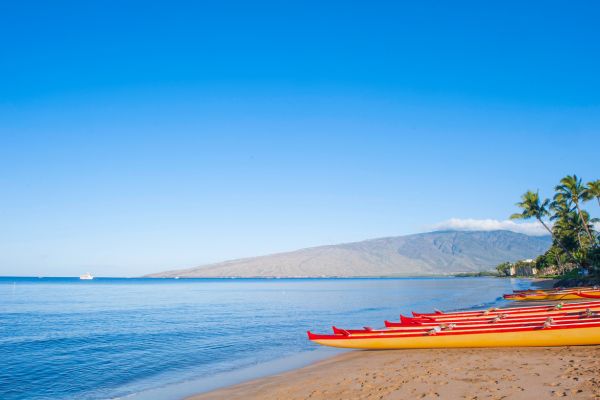
Maui is an island located in the central Pacific Ocean and is part of the state of Hawaii in the United States. It is the second-largest Hawaiian island known for its beautiful beaches, scenic drives, and outdoor activities such as hiking and surfing.
The island is approximately 727 square miles and comprises two large volcanoes, Haleakalā and Mauna Kahalawai, which formed millions of years ago. Maui has a diverse geography with lush rainforests, cascading waterfalls, black sand beaches, and rugged coastlines.
The island is located about 2,400 miles west of the mainland United States and is a popular tourist destination.
Table of Contents
Understanding Maui’s weather
Understanding Maui’s weather and climate is essential for travelers because it can greatly impact their vacation experience. Knowing when to visit and what weather to expect can help travelers plan their itinerary and pack appropriately. For example, the rainy season in Maui can bring flash floods and landslides, making hiking and driving conditions dangerous.
Also, hurricanes and tropical storms are a potential risk during the wet season, which could cause travel disruptions and even cancel flights. On the other hand, the dry season is ideal for beach and outdoor activities, but visitors must be aware of the high UV index and potential for heat exhaustion or dehydration. By understanding Maui’s weather and climate patterns, travelers can prepare themselves accordingly and enjoy their trip to the fullest while staying safe.
General climate characteristics
Maui has a tropical climate with warm temperatures and high humidity throughout the year. The island experiences two distinct seasons – a wet season and a dry season. The weather is influenced by the trade winds that blow from the northeast, which can bring some relief from the heat and humidity.
Annual temperature range and averages
The average temperature in Maui is around 80°F (27°C) year-round, with little variation. However, the temperature can feel warmer or cooler depending on the humidity and wind conditions. The hottest months are from June to September, with temperatures ranging from 85°F (29°C) to 90°F (32°C), while the coolest months are from December to March, with temperatures ranging from 75°F (24°C) to 80°F (27°C).
Overview of Maui’s wet and dry seasons
Maui’s wet season typically runs from November to March, with peak rainfall in December and January. During this time, the island experiences occasional heavy rains and thunderstorms, with high humidity. The dry season runs from April to October, with very little rainfall and lower humidity. The dry season is the peak tourist season on the island, as it offers ideal beach and outdoor activity conditions.

El Niño and La Niña and their potential impacts on Maui’s weather
El Niño and La Niña are weather patterns caused by changes in ocean temperatures in the equatorial Pacific Ocean. El Niño can bring warmer sea surface temperatures, increasing rainfall and more tropical storms or hurricanes.
In contrast, La Niña can cause cooler ocean temperatures, resulting in less rainfall and drier conditions. Both weather patterns can impact Maui’s weather, with El Niño potentially bringing more rainfall and storms during the wet season and La Niña potentially causing drier conditions during the dry season. However, these weather patterns are unpredictable and their impact on Maui’s weather can vary from year to year.
Maui’s wet season
Maui’s wet season, usually occurring from November to March, brings refreshing showers and occasional storms that nourish the island’s vibrant vegetation, create lush waterfalls, and contribute to the island’s stunning natural beauty while still offering plenty of opportunities for exploration and indoor activities.
Months of the wet season
Maui’s wet season typically runs from November to March, with peak rainfall in December and January. However, it’s important to note that rain on the island can occur throughout the year.
Average rainfall
Maui’s average rainfall during the wet season is around 6-8 inches (15-20 cm) per month, with some areas receiving more rainfall than others. The island’s windward side, where the mountains are located, tends to receive more rainfall than the leeward side.
Potential for hurricanes and tropical storms
While Maui is generally not in the direct path of hurricanes or tropical storms, it is still at risk of experiencing their impact. Hurricane season in the Pacific runs from June to November, with the peak season being from August to October. During this time, there is a higher risk of tropical storms or hurricanes forming, which can bring heavy rainfall, strong winds, and dangerous surf conditions.
How to prepare for rainy weather
To prepare for rainy weather in Maui, it’s recommended to pack rain gear such as a waterproof jacket or poncho, and waterproof shoes or sandals. If planning to hike during the wet season, it’s important to check trail conditions and potential closures due to flash floods or landslides. Additionally, it’s important to have a plan in case of power outages or road closures and to monitor weather updates and local news for any potential weather-related warnings or advisories.
Maui’s dry season
Maui’s dry season, typically spanning from April to October, offers visitors a sun-drenched paradise with minimal rainfall, providing ideal conditions for beach activities, outdoor adventures, and exploring the island’s stunning landscapes.

Months of the dry season
Maui’s dry season typically runs from April to October, with the peak dry months being June through September.
Average rainfall
During the dry season, Maui receives very little rainfall. The average rainfall during this time is around 1-2 inches (2.5-5 cm) per month, with some areas receiving even less. However, it’s important to note that there can still be occasional rain showers or brief periods of rain during the dry season.
Temperature range
Maui’s dry season is characterized by warm and sunny weather, with average temperatures ranging from the mid-70s to mid-80s Fahrenheit (24-30 Celsius). Temperatures can occasionally reach into the 90s Fahrenheit (32+ Celsius) during the hottest parts of the day.
What to expect during the dry season
During the dry season, visitors to Maui can expect warm and sunny weather, making it an ideal time for outdoor activities such as hiking, swimming, and snorkeling. The ocean temperatures are also warm and inviting during this time, with average water temperatures ranging from the mid-70s to low-80s Fahrenheit (24-28 Celsius).
However, it’s important to take precautions against the strong UV rays and to stay hydrated, especially during the hotter parts of the day. It’s also important to note that wildfire risk can be high during the dry season, so visitors should be mindful of any fire-related warnings or advisories.
Recommended months for travelers
The best time to visit Maui is from April through May or September through November.
Why these months are the best
During these months, Maui experiences pleasant weather with lower humidity levels, fewer crowds, and more affordable accommodations compared to peak tourist season. In addition, visitors can take advantage of lower airfare rates and enjoy various outdoor activities without the risk of tropical storms or hurricanes.
How to take advantage of the weather during these months
Visitors can take advantage of the mild weather during these months by engaging in various outdoor activities such as hiking, snorkeling, and surfing. The ocean temperatures during these months are also warm and inviting, making it a great time for swimming and other water activities.
Visitors can also explore Maui’s beautiful beaches, national parks, and scenic drives without the crowds that typically come with peak tourist season. It’s important to note that despite the lower risk of tropical storms or hurricanes during these months, visitors should still monitor the weather forecast and take necessary precautions in case of any weather-related warnings or advisories.
Clothing recommendations
Maui’s climate is generally warm throughout the year, so it’s best to pack lightweight and breathable clothing. Visitors should also pack comfortable walking shoes, sandals, a hat, and sunglasses. Packaging a light sweater or jacket for cooler evenings is also recommended.
Essential items for rainy weather
Maui’s wet season typically runs from November to March, so visitors should pack rain gear such as a rain jacket or poncho, waterproof shoes or sandals, and an umbrella. Bringing a waterproof bag to protect electronics and other valuable items is also recommended.
Essential items for sunny weather
Maui’s dry season is from April to October, so visitors should pack sunscreen with a high SPF, a hat or visor, and sunglasses to protect against the sun’s rays. Staying hydrated is also essential, so bringing a refillable water bottle is recommended.
What to pack for hiking and outdoor activities
Maui has several hiking trails and outdoor activities, so visitors should pack comfortable and sturdy hiking shoes, breathable clothing, and a hat. It’s also recommended to bring a small backpack to carry snacks, water, and other essentials. Visitors should pack swimwear and reef-safe sunscreen for water activities such as snorkeling. Visitors may want to consider renting gear from local shops for more adventurous water activities such as surfing or stand-up paddleboarding.







